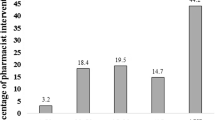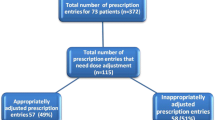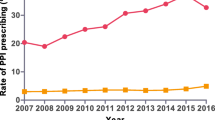Abstract
Background Guidelines recommend use of the oral route whenever possible to treat or prevent hypokalemia. Although a myriad of papers have been published regarding intravenous to oral (IV to PO) therapy conversion programs and about clinical pharmacy services provided in hospitals, little is known on the role of hospital pharmacists in promoting the oral route for potassium administration. Objective The aim of this work was to describe the frequency of interventions related to IV to PO potassium therapy conversions performed by hospital pharmacists. Setting French hospitals recording pharmacist’s interventions on the website tool of the French Society of Clinical Pharmacy. Methods From the pharmacist’s interventions (PI) dataset recorded we extracted all interventions related to potassium IV to PO conversion. We assessed the acceptance rate of these PI by prescribers. Additional free text information in the dataset was analysed. Main outcome measures IV to PO potassium therapy conversions related to potassium chloride. Results From January 2007 to December 2010, 87 hospitals recorded 1,868 PIs concerning IV to PO therapy conversion. Among these, 16 (<1 %) concerned potassium chloride. They were recorded by four hospitals (4.6 %) with respectively 12, 2, 1 and 1 PIs. Six PIs were accepted by physicians and the prescriptions were modified. Conclusion PIs to promote the administration of potassium by the oral route are extremely rare. Our results and scarce previously published data reveal that this field of practice remains almost unexplored. These findings highlight an important gap in the field of intravenous to oral therapy programs. This situation must be regarded as unsatisfactory and should lead to setting up more education and research programs.
Similar content being viewed by others
References
Patient safety alert. ‘High-alert’ medications and patient safety. Int J Qual Health Care. 2001;13:339–40.
Patient safety alert. Medication error prevention: potassium chloride. Int J Qual Health Care. 2001;13:155.
National Patient Safety Agency. Patient safety alert 01. Risks to patients from errors occuring during intravenous administration of potassium solutions. 23 July 2002. NPSA London.
ISMP Canada. Un danger qui se reproduit: les solutions de chlorure de potassium concentrées. Bulletin ISMP Canada. 2004;4:1-2. http://www.ismp-canada.org/fr/dossiers/bulletins/BISMPC2004-03.pdf. Accessed 31 Oct 2013.
Reeve JF, Allinson YM, Stevens A. High-risk medication alert: intravenous potassium chloride. Australian Prescr. 2005;28:14–5.
Australian Commission on Safety and Quality in Healthcare. Medication alert ! Intravenous potassium chloride can be fatal if given inappropriately. http://www.safetyandquality.health.wa.gov.au/docs/medication_safety/KCl%20Medication%20Safety%20Alert.pdf. Accessed 31 Oct 2013.
Cousins DD, Kagemann L. Medication errors: national findings from the USP MEDMARX Medication Error Reporting Program. Hosp Pharm. 2006;41(Supp):S3–10.
Agence nationale de sécurité du médicament et des produits de santé (ANSM). Semaine de la sécurité des patients : l’Afssaps s’engage aux côtés des acteurs du système de soins pour une utilisation plus sûre des médicaments—Communiqué, November 22,2011. http://ansm.sante.fr/S-informer/Presse-Communiques-Points-presse/Semaine-de-la-securite-des-patients-l-Afssaps-s-engage-aux-cotes-des-acteurs-du-systeme-de-soins-pour-une-utilisation-plus-sure-des-medicaments-Communique. Accessed 31 Oct 2013.
World Health Organization. Patient Safety Solutions. Control of concentrated electrolyte solutions. http://www.who.int/patientsafety/solutions/patientsafety/PS-Solution5.pdf. Accessed 31 Oct 2013.
Kim GH, Han JS. Therapeutic approach to hypokalemia. Nephron. 2002;92(Suppl 1):28–32.
Swanson D. Implementing an IV potassium policy. Hosp Pharm. 2003;10:348–52.
Alfonzo AV, Isles C, Geddes C, Deighan C. Potassium disorders—clinical spectrum and emergency management. Resuscitation. 2006;70:10–25.
Rhoda KM, Porter MJ, Quintini C. Fluid and electrolyte management: putting a plan in motion. J Parenter Enteral Nutr. 2011;35:675–85.
Levene DL. Potassium chloride: absorption and excretion. Can Med Assoc J. 1973;7(108):853–5.
Lowance DC, Murad F, Darrow WR, Bonus L. Bioequivalence of a slow-release potassium tablet and a liquid potassium supplement. Int J Clin Pharmacol Ther Toxicol. 1982;20:204–8.
Toner JM, Ramsay LE. Pharmacokinetics of potassium chloride in wax-based and syrup formulations. Br J Clin Pharmacol. 1985;19:489–94.
Melikian AP, Cheng LK, Wright GJ, Cohen A, Bruce RE. Bioavailability of potassium from three dosage forms: suspension, capsule, and solution. J Clin Pharmacol. 1988;28:1046–50.
Kuper KM. Intravenous to oral conversion therapy. Competence Assessment Tools for Health-System Pharmacies, Chapter 29 Fourth Edition, Copyright, 2008, ASHP. http://www.ashp.org/DocLibrary/MemberCenter/ClinicalSpecialistsandScientists/IVtoPO.pdf. Accessed 31 Oct 2013.
Hawkey CJ, Hodgson S, Norman A, Daneshmend TK, Garner ST. Effect of reactive pharmacy intervention on quality of hospital prescribing. BMJ. 1990;300:986–90.
Kaboli PJ, Hoth AB, McClimon BJ, Schnipper JL. Clinical pharmacists and inpatient medical care: a systematic review. Arch Int Med. 2006;166:955–64.
Simonian AI. Documenting pharmacist interventions on an intranet. Am J Health Syst Pharm. 2003;60:151–5.
Allenet B, Bedouch P, Rose FX, Escofier L, Roubille R, Charpiat B, et al. Validation of an instrument for the documentation of clinical pharmacists’ interventions. Pharm World Sci. 2006;28:181–8.
Bedouch P, Charpiat B, Conort O, Rose FX, Escofier L, Juste M, et al. Assessment of clinical pharmacists’ interventions in French hospitals: results of a multicenter study. Ann Pharmacother. 2008;42:1095–103.
Fischer MA, Solomon DH, Teich JM, Avorn J. Conversion from intravenous to oral medications: assessment of a computerized intervention for hospitalized patients. Arch Int Med. 2003;163:2585–9.
Banko H, Goldwater SH, Adams E. Smoothing the path for intravenous (IV) to oral (PO) conversion: where have we come in 11 years? Hosp Pharm. 2009;44:959–67.
Dasta JF, Boucher BA, Brophy GM, Cohen H, Hassan E, Maclaren R, et al. Intravenous to oral conversion of antihypertensives: a toolkit for guideline development. Ann Pharmacother. 2010;44:1430–47.
Ripouteau C, Conort O, Lamas JP, Auleley GR, Hazebroucq G, Durieux P. Effect of multifaceted intervention promoting early switch from intravenous to oral acetaminophen for postoperative pain: controlled, prospective, before and after study. BMJ. 2000;321:1460–3.
Miron D, Tiosano T, Blondheim O, Sorozkin A, Moalem M, Goldstein L, et al. “Concentrated KCL-free” hospital: stopping the use of potassium chloride concentrated ampoules in clinical departments and units–steps in implementing a new policy for increasing safety of drug therapy. Harefuah. 2007;146:650–2 [in Hebrew].
Charpiat B, Leboucher G, Martin I, Richet C, Viale JP. Impact of promotion campaigns for administering potassium orally after an accidental intravenous injection of a concentrated solution. Presse Med. 2010;39:835–6 [in French].
Van de Vreede MA, Wilson SG, Dooley MJ. Intravenous potassium chloride prescribing and administration practices in Victoria: an observational study. Med J Aust. 2008;189:575–7.
Mertz D, Koller M, Haller P, Lampert ML, Plagge H, Hug B. Outcomes of early switching from intravenous to oral antibiotics on medical wards. J Antimicrob Chemother. 2009;64:188–99.
Bardou M, Martin J, Barkun A. Intravenous proton pump inhibitors: an evidence-based review of their use in gastrointestinal disorders. Drugs. 2009;69:435–48.
Hemstreet BA, Stolpman N, Badesch DB, May SK, McCollum M. Potassium and phosphorus repletion in hospitalized patients: implications for clinical practice and the potential use of healthcare information technology to improve prescribing and patient safety. Curr Med Res Opin. 2006;22:2449–55.
Bonvin A, Vantard N, Charpiat B, Pral N, Leboucher G, Philip-Girard F, et al. Accidental intravenous injection of potassium chloride: analysis of contributing factors and barriers to risk reduction. Ann Fr Anesth Reanim. 2009;28:436–41 [in French].
Conort O, Gabardi S, Didier MP, Hazebroucq G, Cariou A. Intravenous to oral conversion of fluoroquinolones: knowledge versus clinical practice patterns. Pharm World Sci. 2002;24:67–70.
Johnson T, Fendrich M. Modeling sources of self-report bias in a survey of drug use epidemiology. Ann Epidemiol. 2005;15:381–9.
Thompson ER, Phua FTT. Reliability among senior managers of the Marlowe-Crowne short-form social desirability scale. J Bus Psychol. 2005;19:541–54.
Colombet I, Sabatier B, Gillaizeau F, Prognon P, Begué D, Durieux P. Long-term effects of a multifaceted intervention to encourage the choice of the oral route for proton pump inhibitors: an interrupted time-series analysis. Qual Saf Health Care. 2009;18:232–5.
van Niekerk AC, Venter DJ, Boschmans SA. Implementation of intravenous to oral antibiotic switch therapy guidelines in the general medical wards of a tertiary-level hospital in South Africa. J Antimicrob Chemother. 2012;67:756–62.
Lau BD, Pinto BL, Thiemann DR, Lehmann CU. Budget impact analysis of conversion from intravenous to oral medication when clinically eligible for oral intake. Clin Ther. 2011;33:1792–6.
Tubman M, Majumdar SR, Lee D, Friesen C, Klassen TP. Best practices for safe handling of products containing concentrated potassium. BMJ. 2005;331:274–7.
Warburton RN. Patient safety–how much is enough? Health Policy. 2005;71:223–32.
Sheldon T. Safety alerts on drugs—how trusts follow the rules. J Health Serv Res Polic. 2010;15(Suppl 1):44–7.
Barras M, Moore D, Pocock D, Sweedman M, Wilkinson C, Taylor K et al. Reducing the risk of harm from intravenous potassium: A multi-factorial approach in the haematology setting. J Oncol Pharm Pract 2013 Sept 20. [Epub ahead of print].
Esmail R, Cummings C, Dersch D, Duchscherer G, Glowa J, Liggett G, et al. Using Healthcare Failure Mode and Effect Analysis tool to review the process of ordering and administrating potassium chloride and potassium phosphate. Healthc Q. 2005;8:73–80.
Acknowledgments
We thank Dr Alison Foote of the Grenoble Clinical Research Centre for critically editing the manuscript including for English usage.
Funding
This study was supported by a grant from The French Society of Clinical Pharmacy, a nonprofit foundation for clinical pharmacy research and development.
Conflicts of interest
None.
Author information
Authors and Affiliations
Corresponding author
Rights and permissions
About this article
Cite this article
Charpiat, B., Bedouch, P., Conort, O. et al. Pharmacists’ interventions on intravenous to oral conversion for potassium. Int J Clin Pharm 36, 513–518 (2014). https://doi.org/10.1007/s11096-014-9916-y
Received:
Accepted:
Published:
Issue Date:
DOI: https://doi.org/10.1007/s11096-014-9916-y




